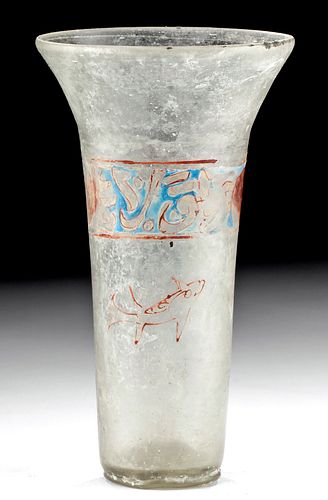13th C. Islamic Enamel Decorated Glass Beaker - Shark
Lot 82d
About Seller
Artemis Fine Arts
686 S Taylor Ave, Ste 106
Louisville, CO 80027
United States
Selling antiquities, ancient and ethnographic art online since 1993, Artemis Gallery specializes in Classical Antiquities (Egyptian, Greek, Roman, Near Eastern), Asian, Pre-Columbian, African / Tribal / Oceanographic art. Our extensive inventory includes pottery, stone, metal, wood, glass and textil...Read more
Categories
Estimate:
$2,000 - $3,000
Absentee vs Live bid
Two ways to bid:
- Leave a max absentee bid and the platform will bid on your behalf up to your maximum bid during the live auction.
- Bid live during the auction and your bids will be submitted real-time to the auctioneer.
Bid Increments
| Price | Bid Increment |
|---|---|
| $0 | $25 |
| $300 | $50 |
| $1,000 | $100 |
| $2,000 | $250 |
| $5,000 | $500 |
| $10,000 | $1,000 |
| $20,000 | $2,500 |
| $50,000 | $5,000 |
| $100,000 | $10,000 |
| $200,000 | $20,000 |
About Auction
By Artemis Fine Arts
Feb 13, 2020
Set Reminder
2020-02-13 10:00:00
2020-02-13 10:00:00
America/New_York
Bidsquare
Bidsquare : Exceptional Antiquities, Asian, Ethnographic
https://www.bidsquare.com/auctions/artemis-gallery/exceptional-antiquities-asian-ethnographic-4848
An important one-day auction featuring museum-worthy examples of Egyptian, Greek, Roman, Etruscan, Near Eastern, Far East / Asian, Pre-Columbian, African / Tribal, Oceanic, Native American, Spanish Colonial, Russian, Fossils, Ancient Jewelry, Fine Art, so much more! Artemis Fine Arts info@artemisfinearts.com
An important one-day auction featuring museum-worthy examples of Egyptian, Greek, Roman, Etruscan, Near Eastern, Far East / Asian, Pre-Columbian, African / Tribal, Oceanic, Native American, Spanish Colonial, Russian, Fossils, Ancient Jewelry, Fine Art, so much more! Artemis Fine Arts info@artemisfinearts.com
- Lot Description
Ancient Near / Middle East, Egypt or Syria, Mamluk Period, ca. end of 13th to early 14th century CE. One of my favorites! A gorgeously preserved example of a decorative enameled beaker, free blown and with a narrow body that flares outward to a wide mouth with a slightly thickened rim. Around the center is an enameled band of red and blue that is worn from age but appears to include Kufic script centered around two round bosses. Below that band are two dark red outline images of sharks, one quite well preserved and very clear. Size: 2.85" W x 5" H (7.2 cm x 12.7 cm)
From the Metropolitan Museum of Art's essay, "Enameled and Gilded Glass from Islamic Lands", the curators write: "Enameled and gilded glass developed in the twelfth century in the Syrian area and flourished during the final decades of Ayyubid power and the first of Mamluk domination in the thirteenth century. As Cairo became the capital of the empire in the fourteenth century, most enameled and gilded glass from that time may be attributed to Egyptian, rather than Syrian, workshops. The late fourteenth century saw a decline in production; by the early fifteenth century, dwindling patronage eventually caused workshops to close. By the late fifteenth century, the production of most enameled glass had shifted to Europe—to Venice, in particular."
See a nearly identical example sold at Christie's Paris on March 4-5, 2008, Lot 25 (EUR 264,250); another with a similar shark image is at the Hermitage Museum, Saint Petersburg, Russia (EF-1357).
Provenance: ex-Boisgirard & Associates auction, France (December 2010, lot 202); ex-Christopher Sheppard collection, London, U.K., acquired in the 1980s
All items legal to buy/sell under U.S. Statute covering cultural patrimony Code 2600, CHAPTER 14, and are guaranteed to be as described or your money back.
A Certificate of Authenticity will accompany all winning bids.
We ship worldwide and handle all shipping in-house for your convenience.
#152898Intact, with light deposits on the surface. Much of the enamel is still visible, especially one of the sharks. There is a clear pontil scar on the underside. A pontil scar or mark indicates that a vessel was free-blown, while the absence of such a mark suggests that the work was either mold-blown or that the mark was intentionally smoothed away or wore away over time.Condition
- Shipping Info
-
All shipping is handled in-house for your convenience. Your invoice from Artemis Gallery will include shipping calculation instructions. If in doubt, please inquire BEFORE bidding for estimated shipping costs for individual items.
-
- Buyer's Premium



 EUR
EUR CAD
CAD AUD
AUD GBP
GBP MXN
MXN HKD
HKD CNY
CNY MYR
MYR SEK
SEK SGD
SGD CHF
CHF THB
THB















